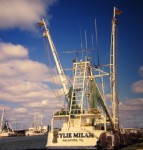 Taken in Colorado September 2011. I call him Biker Bob, actually I don’t have a clue as to who he is. Taken with the spud, handheld, available light. I thought he looked cool on his bike.
Taken in Colorado September 2011. I call him Biker Bob, actually I don’t have a clue as to who he is. Taken with the spud, handheld, available light. I thought he looked cool on his bike.
Author Archives: dorothy mladenka
Rocky Mountain National Park Female Elk
Elk at Rocky Mountain National Park
Do Not Talk To Prisoners Through Bars!
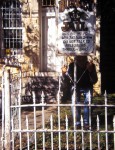 Taken in Burnet, Texas in 2014. This historic jail was built in 1884 of hand-hewn rock. It has an apartment for the sheriff who is also the jailer. On the second floor the county library was founded. The former jail is still being used by one of the county departments. The city of Burnet is nestled in the heart of the Texas Hill Country surrounded by rolling hills, lakes, beautiful geologic formations and historical sites. The historic square features buildings from as early as the 1880’s and offers a variety of unique shops and eateries. Drive in or take the Hill Country Flyer Historic Train (which is what we did) from Cedar Park, located on the edge of Austin. Watch the Burnet Gunfighter’s fight it out at the Old West Town on Saturday and Sunday. Taken with the TL120, available light handheld.
Taken in Burnet, Texas in 2014. This historic jail was built in 1884 of hand-hewn rock. It has an apartment for the sheriff who is also the jailer. On the second floor the county library was founded. The former jail is still being used by one of the county departments. The city of Burnet is nestled in the heart of the Texas Hill Country surrounded by rolling hills, lakes, beautiful geologic formations and historical sites. The historic square features buildings from as early as the 1880’s and offers a variety of unique shops and eateries. Drive in or take the Hill Country Flyer Historic Train (which is what we did) from Cedar Park, located on the edge of Austin. Watch the Burnet Gunfighter’s fight it out at the Old West Town on Saturday and Sunday. Taken with the TL120, available light handheld.
Goliad Market Days, Texas
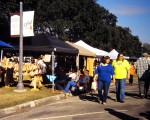 Goliad Market Days is an open air market which combines an arts and crafts fair, farmers market and community festival. Market Days are held to relive Goliad’s traditional role as a crossroads for commerce, beginning with the 1700s’ Spanish-colonial trade from Mexico to Nacogdoches. The tradition continued throughout the 19th century, as Goliad was included on the routes for oxcarts, freight wagons, and stagecoaches. Today, Goliad Market Days is one of the largest and most popular street markets in South Texas. Goliad is the third oldest municipality and is rich in Texas history. It is the County Seat of Goliad County, one of the oldest counties of Texas. First named Santa Dorotea by the Spaniards in the 16th century, its name was changed February 4, 1829 to Goliad. The name is an anagram derived from the last name of a Spanish missionary priest, Father Hidalgo.
Goliad Market Days is an open air market which combines an arts and crafts fair, farmers market and community festival. Market Days are held to relive Goliad’s traditional role as a crossroads for commerce, beginning with the 1700s’ Spanish-colonial trade from Mexico to Nacogdoches. The tradition continued throughout the 19th century, as Goliad was included on the routes for oxcarts, freight wagons, and stagecoaches. Today, Goliad Market Days is one of the largest and most popular street markets in South Texas. Goliad is the third oldest municipality and is rich in Texas history. It is the County Seat of Goliad County, one of the oldest counties of Texas. First named Santa Dorotea by the Spaniards in the 16th century, its name was changed February 4, 1829 to Goliad. The name is an anagram derived from the last name of a Spanish missionary priest, Father Hidalgo.
Palacios, Texas
Reflections on Lake Chapala, Mexico
 Lake Chapala is Mexico’s largest fresh water lake. It is located 45 km southeast of Guadalajara, Jalisco, and is situated on the border between the states of Jalisco and Michoacán, at 1,524 metres (5000 feet) above sea level. It is a shallow lake, with a mean depth of 4.5 metres (14.9 feet) and a maximum of 10.5 (34 feet). The lake is also a critical habitat for several species of migratory birds, such as the American white pelican, and home to thousands of indigenous plants and animals. It is also home to a large contingent of expats from Canada and the United States. It is a gorgeous place and I can see why people retire here.
Lake Chapala is Mexico’s largest fresh water lake. It is located 45 km southeast of Guadalajara, Jalisco, and is situated on the border between the states of Jalisco and Michoacán, at 1,524 metres (5000 feet) above sea level. It is a shallow lake, with a mean depth of 4.5 metres (14.9 feet) and a maximum of 10.5 (34 feet). The lake is also a critical habitat for several species of migratory birds, such as the American white pelican, and home to thousands of indigenous plants and animals. It is also home to a large contingent of expats from Canada and the United States. It is a gorgeous place and I can see why people retire here.
Wylie Milam
Concepcion Mission Church
Concepcion (1731)
One 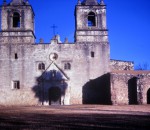 of the most attractive of the San Antonio missions, the church at Concepcion looks essentially as it did more than 200 years ago, when it stood at the center of local religious activity. The mission was well known for its religious celebrations. Not visible today are the colorful geometric designs that originally covered the exterior surface of the mission. Inside, however, are original paintings of religious symbols and architectural designs. These outposts were established by Catholic religious orders to spread Christianity among the local natives. These missions formed part of a colonization system that stretched across the Spanish Southwest in the 17th, 18th, and 19th centuries. This is one of the 5 San Antonio missions, the Alamo is owned by the state of Texas and operated by the Daughters of the Revolution. The National Historical Park encompasses 4 of the missions. Taken with the TL 120.
of the most attractive of the San Antonio missions, the church at Concepcion looks essentially as it did more than 200 years ago, when it stood at the center of local religious activity. The mission was well known for its religious celebrations. Not visible today are the colorful geometric designs that originally covered the exterior surface of the mission. Inside, however, are original paintings of religious symbols and architectural designs. These outposts were established by Catholic religious orders to spread Christianity among the local natives. These missions formed part of a colonization system that stretched across the Spanish Southwest in the 17th, 18th, and 19th centuries. This is one of the 5 San Antonio missions, the Alamo is owned by the state of Texas and operated by the Daughters of the Revolution. The National Historical Park encompasses 4 of the missions. Taken with the TL 120.
Mazamitla, Mexico
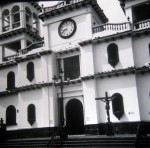 Mazamitla is located in the south-central area of Jalisco, south of Lake Chapala. Mazamitla is in the pine woods, more than 7000 feet up, clean air, cooler temperatures, a beautiful setting. San Cristobal Parish Church is an architectural wonder, blessed, for some reason, with an exterior that stirs thoughts of a Chinese pagoda. As usual, it appears freshly painted, white trimmed in red. There were flowers at the entrance. History says the clock in the tower has trouble keeping time. This image was taken with the spud Tech Pan film reversal process. How I miss Mexico!!!
Mazamitla is located in the south-central area of Jalisco, south of Lake Chapala. Mazamitla is in the pine woods, more than 7000 feet up, clean air, cooler temperatures, a beautiful setting. San Cristobal Parish Church is an architectural wonder, blessed, for some reason, with an exterior that stirs thoughts of a Chinese pagoda. As usual, it appears freshly painted, white trimmed in red. There were flowers at the entrance. History says the clock in the tower has trouble keeping time. This image was taken with the spud Tech Pan film reversal process. How I miss Mexico!!!
Prada Marfa
The brainchild of Berlin-based artistic team Elmgreen and Dragset, Prada Marfa was meant to be a “pop architectural land art project.” Built of a biodegradable adobe-like substance, the building is meant to slowly melt back into the Earth, serving as a surrealist commentary on Western materialism. Prada Marfa is located northwest of Valentine, Texas, just off U.S. Route 90, and about 60 km northwest of the city of Marfa. Costing a sum total of $80,000 – or, put another way, about 40 Prada handbags
 Due to vandalism the handbags have no bottoms and all of the shoes are right-footed. While the vandalism might be the most exciting thing that’s ever happened to Prada Marfa, the site still gets thousands of visitors a year, despite Route 90’s low traffic flow Most people buy the artists’ story, but a few vocal dissenters have flooded the internet with conspiracy theories. Some even argue that Prada Marfa is a trap set by aliens meant to attract potential abductees. Visitors beware.
Due to vandalism the handbags have no bottoms and all of the shoes are right-footed. While the vandalism might be the most exciting thing that’s ever happened to Prada Marfa, the site still gets thousands of visitors a year, despite Route 90’s low traffic flow Most people buy the artists’ story, but a few vocal dissenters have flooded the internet with conspiracy theories. Some even argue that Prada Marfa is a trap set by aliens meant to attract potential abductees. Visitors beware.
In March of 2014, the Prada in Marfa was vandalized with blue paint and graffiti. Image was taken with the TL 120.
Tajin
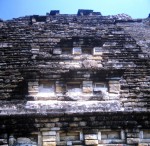 Located in the state of Veracruz, El Tajin was at its height from the early 9th to the early 13th century. It became the most important centre in north-east Mesoamerica after the fall of the Teotihuacan Empire. Its cultural influence extended all along the Gulf and penetrated into the Maya region and the high plateaux of central Mexico. Its architecture, which is unique in Mesoamerica, is characterized by elaborate carved reliefs on the columns and frieze. The ‘Pyramid of the Niches’, a masterpiece of ancient Mexican and American architecture, reveals the astronomical and symbolic significance of the buildings. El Tajin has survived as an outstanding example of the grandeur and importance of the pre-Hispanic cultures of Mexico. Taken with the spud, hand held.
Located in the state of Veracruz, El Tajin was at its height from the early 9th to the early 13th century. It became the most important centre in north-east Mesoamerica after the fall of the Teotihuacan Empire. Its cultural influence extended all along the Gulf and penetrated into the Maya region and the high plateaux of central Mexico. Its architecture, which is unique in Mesoamerica, is characterized by elaborate carved reliefs on the columns and frieze. The ‘Pyramid of the Niches’, a masterpiece of ancient Mexican and American architecture, reveals the astronomical and symbolic significance of the buildings. El Tajin has survived as an outstanding example of the grandeur and importance of the pre-Hispanic cultures of Mexico. Taken with the spud, hand held.
Shadows On the Teche
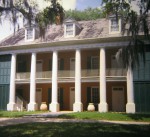 Located in New Iberia’s Main Street District, set among towering live oak trees draped with Spanish moss on the banks of Bayou Teche, The Shadows, built in 1834 for sugar planter David Weeks, paints a vivid picture of life for the four generations that made this property their home. The Shadows is a Classic Revival-style home with a Louisiana Colonial floor plan and a garden that is as breathtaking as the history preserved here. Continue reading
Located in New Iberia’s Main Street District, set among towering live oak trees draped with Spanish moss on the banks of Bayou Teche, The Shadows, built in 1834 for sugar planter David Weeks, paints a vivid picture of life for the four generations that made this property their home. The Shadows is a Classic Revival-style home with a Louisiana Colonial floor plan and a garden that is as breathtaking as the history preserved here. Continue reading
Grrrrrrrrrr!
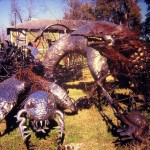 Former car parts and spoons take the shapes of mysterious creatures including prehistoric reptiles, bugs, and even aliens at Scrap Daddy’s Art Yard. Art forms are scattered throughout this museum of sorts, among overgrown grass and metal scraps. Welder and gallery owner, Mark Bradford has an eclectic eye for art that has moved him to put his own distinctive mark on the many metal sculptures displayed in the outdoor gallery. Sights for innovative eyes include the 20-foot praying mantis (that I can’t get out of my mind), a flying saucer, and an automobile-sized scorpion. Bradford welcomes free visits to his yard daily.
Former car parts and spoons take the shapes of mysterious creatures including prehistoric reptiles, bugs, and even aliens at Scrap Daddy’s Art Yard. Art forms are scattered throughout this museum of sorts, among overgrown grass and metal scraps. Welder and gallery owner, Mark Bradford has an eclectic eye for art that has moved him to put his own distinctive mark on the many metal sculptures displayed in the outdoor gallery. Sights for innovative eyes include the 20-foot praying mantis (that I can’t get out of my mind), a flying saucer, and an automobile-sized scorpion. Bradford welcomes free visits to his yard daily.
Michele de George
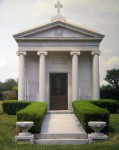 Image taken with the TL 120 in a local cemetery. The Glenwood Cemetery is located at 2525 Washington Avenue in Houston, Texas. It was the first cemetery in Houston to be professionally designed and opened in 1871. The cemetery is situated between Washington Avenue on the North side and Memorial Drive on the South side, the latter overlooking Buffalo Bayou. Designed in the tradition of other romantic rural cemetery parks of the 19th century, Glenwood’s beautiful landscape and towering trees provide the visitor a place of quiet respite just one mile west of downtown Houston.
Image taken with the TL 120 in a local cemetery. The Glenwood Cemetery is located at 2525 Washington Avenue in Houston, Texas. It was the first cemetery in Houston to be professionally designed and opened in 1871. The cemetery is situated between Washington Avenue on the North side and Memorial Drive on the South side, the latter overlooking Buffalo Bayou. Designed in the tradition of other romantic rural cemetery parks of the 19th century, Glenwood’s beautiful landscape and towering trees provide the visitor a place of quiet respite just one mile west of downtown Houston.



